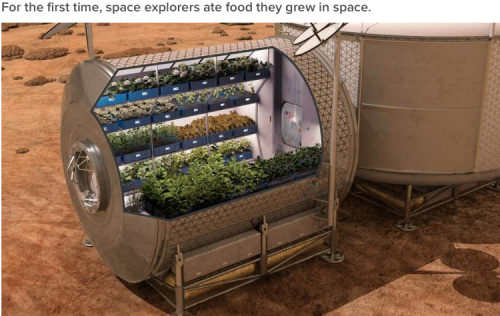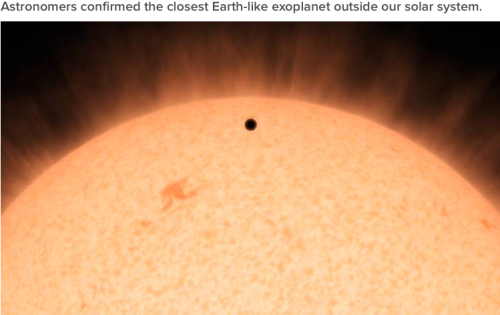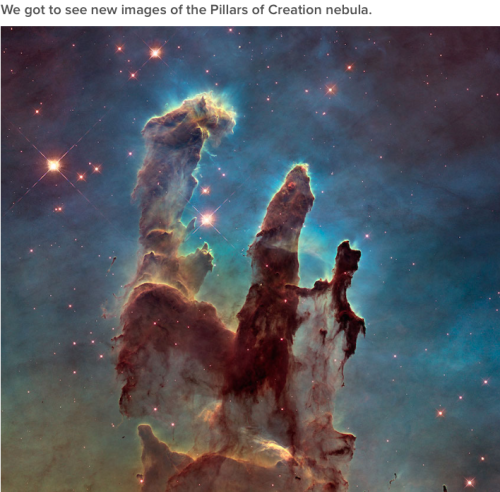The Shakespearean Moons Of Uranus
The Shakespearean Moons of Uranus
This weekend marks the 400th anniversary of Shakespeare’s death, and we’re highlighting the moons of Uranus; some of which are named after characters from his works.

While most of the moons orbiting other planets take their names from Greek mythology, Uranus’ moons are unique in bing named for Shakespearean characters, along with a couple of them being named for characters from the works of Alexander Pope.

Using the Hubble Space Telescope and improved ground-based telescopes, astronomers have discovered a total of 27 known moons around Uranus.
Here’s a sampling of some of the unique aspects of the moons:
Miranda

Shakespearean work: The Tempest
Miranda, the innermost and smallest of the five major satellites, has a surface unlike any other moon that’s been seen. It has a giant fault canyon as much as 12 times as deep as the Grand Canyon, terraced layers and surfaces that appear very old, and others that look much younger.
Ariel

Shakespearean work: The Tempest
Ariel has the brightest and possibly the youngest surface among all the moons of Uranus. It has a few large craters and many small ones, indicating that fairly recent low-impact collisions wiped out the large craters that would have been left by much earlier, bigger strikes. Intersecting valleys pitted with craters scars its surface.
Oberon

Shakespearean work: A Midsummer Night’s Dream
Oberon, the outermost of the five major moons, is old, heavily cratered and shows little signs of internal activity. Unidentified dark material appears on the floors of many of its craters.
Cordelia and Ophelia

Shakespearean works: Cordelia - King Lear; Ophelia - Hamlet
Cordelia and Ophelia are shepherd moons that keep Uranus’ thin, outermost “epsilon” ring well defined.
Between them and miranda is a swarm of eight small satellites unlike any other system of planetary moons. This region is so crowded that astronomers don’t yet understand how the little moons have managed to avoid crashing into each other. They may be shepherds for the planet’s 10 narrow rings, and scientists think there must be still more moons, interior to any known, to confine the edges of the inner rings.
Want to learn more about all of Uranus’s moons? Visit: http://solarsystem.nasa.gov/planets/uranus/moons
Check out THIS blog from our Chief Scientist Ellen Stofan, where she reflects on the life and legacy of William Shakespeare on the 400th anniversary of his death on April 23, 1616.
Make sure to follow us on Tumblr for your regular dose of space: http://nasa.tumblr.com
More Posts from I-lik3-giants and Others
'Let's lie very still and quiet and hold each other and not think at all.'
Ernest Hemingway, The Garden of Eden (via klytemnestre)









Space Photos of the Week
guy moans










If you couldn’t tell already, NASA is having a great year. From Pluto to food grown in space, even in the face of budget cuts, the nation’s space agency had some stellar highlights. Most mysteriously of all, a spacecraft found two eerily bright lights on a distant dwarf planet.
quiero ser astronauta 🌌
7 Things That Happen When You Go To Space
Told Through Astronaut Scott Kelly’s Tweets
Astronaut Scott Kelly is currently spending a year in space. Most expeditions to the space station last four to six months. By doubling the length of this mission, researchers hope to better understand how the human body reacts and adapts to long-duration spaceflight. During this one-year mission, Kelly is also participating in the Twins Study. While Kelly is in space, his identical twin brother, retired NASA Astronaut Mark Kelly, will participate in a number of comparative genetic studies.
Here are a few things that happen when astronauts go to the space station:
1. Your personal hygiene takes on a different form:


2. Sleeping arrangements might take some getting used to:



3. Internet services will remind you of the 90s:

4. You never have to do laundry:


5. You get to become immersed in a range of different cultures:

6. All of your water is recycled…yes…that means urine too:


7. You get to see the Earth like never before:



Follow Astronaut Scott Kelly’s Year in Space mission on Facebook, Twitter and Instagram.
Make sure to follow us on Tumblr for your regular dose of space: http://nasa.tumblr.com
Dope af
Hitchhiking a Ride to Space
Have you ever packed for a long trip with a friend and ran out of space in your suitcase? Maybe your friend was nice and let your spare items hitchhike a ride in their bag? The following science experiments are doing something similar on our Space Launch System rocket.

Our Space Launch System (SLS) will be the most powerful rocket we’ve ever built and will enable astronauts in the Orion spacecraft to travel deeper into the solar system. This advanced launch vehicle will launch astronauts to an asteroid and eventually to Mars, while opening new possibilities for other payloads including robotic scientific missions to places like Mars, Saturn and Jupiter.

The primary goal of SLS and the Orion spacecraft is to launch future crewed, deep space missions. That said, an added bonus of this powerful rocket is the extra science it can carry. On it’s first mission (known as Exploration Mission-1, EM-1) SLS will carry 13 CubeSats (small satellites, each the size of a large shoebox) on its first flight as secondary payloads. These small satellites will perform various in-space experiments. In a way, these 13 CubeSats are ‘space hitchhikers’, catching a ride to deep space where they can gather data valuable to future exploration missions.

How were these 13 experiments selected? Great question. They were selected through a series of announcements of flight opportunities, a public contest and negations with our international partners.
These secondary payloads have a vast array of functions, from taking pictures of asteroids, to using yeast to detect impacts of deep-space radiation. Each month we will highlight one of these experiments on Tumblr and talk about all the exciting science they will do. Just to give you an idea of what these shoebox-sized satellites will do, we’ll give you a preview:
1. NEA Scout

NEA Scout, stands for: Near-Earth Asteroid Scout. This CubeSat will investigate an asteroid, taking pictures and observe its position in space.
2. BioSentinel

BioSentinel will be the first time living organisms have traveled to deep space in more than 40 years. It will use yeast to detect, measure and compare the impact of deep-space radiation on living organisms over long durations in deep space.
3. Lunar Flashlight

This experiment will look for ice deposits and identify locations where resources may be extracted from the lunar surface. It will demonstrate the capability to scout for useful materials and resources from lunar orbit.
4. Skyfire

Lockheed Martin’s Skyfire will perform a lunar flyby, collecting data to address both Moon and Mars Strategic Knowledge Gaps, or gaps in information required to reduce risk, increase effectiveness and improve the design of robotic and human space exploration missions, for surface characterization, remote sensing and site selection.
5. Lunar IceCube

Morehead State University’s Lunar IceCube will look for water in ice, liquid and vapor forms from a very low orbit of only 62 miles above the surface of the moon. The ability to search for useful resources can potentially help astronauts manufacture fuel and necessities to sustain a crew.
6. CuSP

The CubeSat mission to study Solar Particles, or CuSP, will be the first protype of an interplanetary CubeSat space weather station. It will observe space weather events hours before they reach Earth.
7. Luna-H-Map

Lunar Polar Hydrogen Mapper (LunaH) will enter a polar orbit around the moon with a low altitude. From there, it will produce maps of near-surface hydrogen.
8, 9, 10. Three Tournament Payloads

Three of the payloads riding along on this journey will be the winners of the Ground Tournaments portion of our CubeQuest Challenge. This challenge is designed to foster innovation in small spacecraft propulsion and communications techniques. Learn more about this challenge HERE.
11, 12, 13. International Partners
The remaining three payloads are reserved for international partners, and will be announced at a later time.
To stay updated on these experiments, visit: http://www.nasa.gov/launching-science-and-technology.html
Make sure to follow us on Tumblr for your regular dose of space: http://nasa.tumblr.com

even if you can’t vote
i get a lot of questions about how to contribute to the campaign without being able to vote, and right now is a pivotal time for us to be supporting Bernie Sanders in every way we can.
if you’re too young, not registered, not eligible, not a US citizen or living in the US, or already voted and still want to help, you can still contribute! right now closing the delegate gap is more important than the individual state primaries, and to make any difference on that front we need more volunteers.
the best thing to do right now, even if you're voting/have voted, is to volunteer for the campaign and work with your local Bernie supporters to get more delegates. below are links to websites where you can find contact information for the remaining states. contact someone on the local campaign (in your area, or in any state you think needs support!) and ask them how you can best help their efforts. I’ve been doing phone banking and collecting signatures for delegates in rhode island, as well as attending events and hanging out fliers, and trust me when i say any little bit helps.
remember, Obama lost more states to Hillary at this point in the primary than Bernie has. he had the delegate support, and there’s still time to catch up to Hillary’s numbers if we all pitch in.
here is a list of all the states left in the primary, and the website for their local grassroots movement:
Arizona (Mar 22): Website: http://arizonaforsanders.org/
Idaho (Mar 22): Website: http://voteforbernie.org/state/idaho/
Utah (Mar 22): Website: http://www.utahforberniesanders.com/ Alaska (Mar 26): Website: http://voteforbernie.org/state/alaska/ Hawaii (Mar 26): Website: http://hawaiiforbernie.com/ Washington (Mar 26): Website: http://washingtonforberniesanders.com/
Wisconsin (Apr 5): Website: http://wi.forberniesanders.com/
Wyoming (Apr 9): Website: http://voteforbernie.org/state/wyoming/ New York (Apr 19): Website: http://teambernieny.org/ Connecticut (Apr 26): Website: http://www.berniesandersct.com/ Delaware (Apr 26): Website: http://voteforbernie.org/state/delaware/
Maryland (Apr 26): Website: http://www.berniesandersvideo.com/maryland.html Pennsylvania (Apr 26): Website: www.pa.forberniesanders.com/events Rhode Island (Apr 26): Website: www.rhodeisland.forberniesanders.com/ (or contact me)
Indiana (May 3): Website: http://voteforbernie.org/state/indiana/ Guam (May 7): Website: https://go.berniesanders.com/page/event/detail/volunteermeetingtogetorganizedorlearnmore/4v28f Nebraska (May 10): Website: http://voteforbernie.org/state/nebraska/
West Virginia (May 10): Website: http://voteforbernie.org/state/west-virginia/
Kentucky (May 17): Website: http://voteforbernie.org/state/kentucky/ Oregon (May 17): Website: https://oregonforbernie.com Virgin Island (Jun 4): Website: https://www.facebook.com/democratsvi/ (no specific Bernie Sanders website or page yet- make your own!)
Puerto Rico (Jun 5): Website: http://voteforbernie.org/state/puerto-rico/ California (Jun 7): Website: http://voteforbernie.org/state/california/ Montana (Jun 7): Website: http://www.mtforbernie.com/ New Jersey (Jun 7): Website: http://newjersey.forberniesanders.com/ New Mexico (Jun 7): Website: www.nm.forberniesanders.com/ North Dakota (Jun 7): Website: http://voteforbernie.org/state/north-dakota/ South Dakota (jun 7): Website: http://voteforbernie.org/state/south-dakota/
District of Columbia (Jun 14): Website: http://voteforbernie.org/state/washington-dc/
if you have any questions, if you need help registering/finding who to contact, or you just wanna talk about Bernie Sanders, don’t hesitate to send me a message!
5 Myths About Becoming an Astronaut
Have you ever wondered if you have what it takes to become a NASA Astronaut? The term “astronaut” derives from the Greek word meaning “space sailor,” and refers to all who have been launched as crew members aboard NASA spacecraft bound for orbit and beyond.
We’re looking for a new class of astronauts to join the NASA team, and here are a few things to know.
Here are a few myths about becoming an astronaut:
MYTH: All astronauts have piloting experience.
FACT: You don’t need to be a pilot to be an astronaut. Flying experience is not a requirement, but could be beneficial to have.

MYTH: All astronauts have perfect vision.
FACT: It’s okay if you don’t have 20/20 vision. As of September 2007, corrective surgical procedures of the eye (PRK and LASIK), are now allowed, providing at least 1 year has passed since the date of the procedure with no permanent adverse after effects.

MYTH: All astronauts have advanced degrees like, a PhD.
FACT: While a Bachelor’s degree from an accredited university is necessary, an advanced degree is not required to become an astronaut.

MYTH: Astronauts are required to have military experience in order to be selected.
FACT: Military experience is not required to become an astronaut.

MYTH: You have to be a certain age in order to be an astronaut.
FACT: There are no age restrictions. Astronaut candidates selected in the past have ranged between the ages of 26 and 46, with the average age being 34.

Okay, but What are the requirements?

Basic Qualification Requirements
Applicants must meet the following minimum requirements before submitting an application.
Bachelor’s degree from an accredited institution in engineering, biological science, physical science or mathematics.
Degree must be followed by at least 3 years of related, progressively responsible, professional experience or at least 1,000 pilot-in-command time in jet aircraft. An advanced degree is desirable and may be substituted for experience as follows: master’s degree = 1 year of experience, doctoral degree = 3 years of experience. Teaching experience, including experience at the K - 12 levels, is considered to be qualifying experience for the Astronaut Candidate position; provided degree is in a Science, Engineering, or Mathematics field.
Ability to pass the NASA Astronaut physical, which includes the following specific requirements:
Distant and near visual acuity: Must be correctable to 20/20, each eye
The refractive surgical procedures of the eye, PRK and LASIK, are allowed, providing at least 1 year has passed since the date of the procedure with no permanent adverse after effects. For those applicants under final consideration, an operative report on the surgical procedure will be requested.
Blood pressure not to exceed 140/90 measured in a sitting position
Standing height between 62 and 75 inches
Applications for our next astronaut class open on Dec. 14! Visit: http://www.nasa.gov/astronauts/
Make sure to follow us on Tumblr for your regular dose of space: http://nasa.tumblr.com
my snoop 💛










After 65 years of Charlie Brown, Snoopy and the whole Peanuts gang, what keeps us coming back again and again?
“The ‘Peanuts’ story is arguably one of the longest-running works of contemporary American literature of our time,” author and editor Chip Kidd told us today as we explored the new “Peanuts” movie and his new Schulz retrospective, “Only What’s Necessary.”
(Charlie Brown is Back, October 23, 2015)
[Images courtesy of the Charles M. Schulz Museum and Research Center, Santa Rosa, California]
-
 leda-timeandspace liked this · 1 year ago
leda-timeandspace liked this · 1 year ago -
 blueartofnature-blog liked this · 2 years ago
blueartofnature-blog liked this · 2 years ago -
 luminouslumity reblogged this · 4 years ago
luminouslumity reblogged this · 4 years ago -
 luminouslumity liked this · 4 years ago
luminouslumity liked this · 4 years ago -
 chedel liked this · 5 years ago
chedel liked this · 5 years ago -
 radiumkind liked this · 5 years ago
radiumkind liked this · 5 years ago -
 godcomplexxxes liked this · 6 years ago
godcomplexxxes liked this · 6 years ago -
 maidalun liked this · 6 years ago
maidalun liked this · 6 years ago -
 juicycloverr liked this · 6 years ago
juicycloverr liked this · 6 years ago -
 yearoftheperfectfury liked this · 7 years ago
yearoftheperfectfury liked this · 7 years ago -
 rh35211 reblogged this · 7 years ago
rh35211 reblogged this · 7 years ago -
 asylvermoment liked this · 8 years ago
asylvermoment liked this · 8 years ago -
 queenoftheothernight liked this · 8 years ago
queenoftheothernight liked this · 8 years ago -
 midnightinjapan liked this · 8 years ago
midnightinjapan liked this · 8 years ago -
 behemothwifey liked this · 8 years ago
behemothwifey liked this · 8 years ago -
 s-t-e-l-l-a-luna reblogged this · 8 years ago
s-t-e-l-l-a-luna reblogged this · 8 years ago -
 s-t-e-l-l-a-luna liked this · 8 years ago
s-t-e-l-l-a-luna liked this · 8 years ago -
 agush111-blog liked this · 8 years ago
agush111-blog liked this · 8 years ago -
 antisisyphus reblogged this · 8 years ago
antisisyphus reblogged this · 8 years ago -
 superspacenerdblog reblogged this · 8 years ago
superspacenerdblog reblogged this · 8 years ago -
 k0mad0ri liked this · 8 years ago
k0mad0ri liked this · 8 years ago -
 fallbaby55 reblogged this · 8 years ago
fallbaby55 reblogged this · 8 years ago -
 hopeless-enough reblogged this · 8 years ago
hopeless-enough reblogged this · 8 years ago -
 eerie-innocence42 reblogged this · 8 years ago
eerie-innocence42 reblogged this · 8 years ago -
 doh-bama liked this · 8 years ago
doh-bama liked this · 8 years ago -
 the-boy-blunder reblogged this · 8 years ago
the-boy-blunder reblogged this · 8 years ago -
 agentofnightvale-blog reblogged this · 8 years ago
agentofnightvale-blog reblogged this · 8 years ago -
 para-gem reblogged this · 8 years ago
para-gem reblogged this · 8 years ago -
 fluorescentlust-blog liked this · 8 years ago
fluorescentlust-blog liked this · 8 years ago